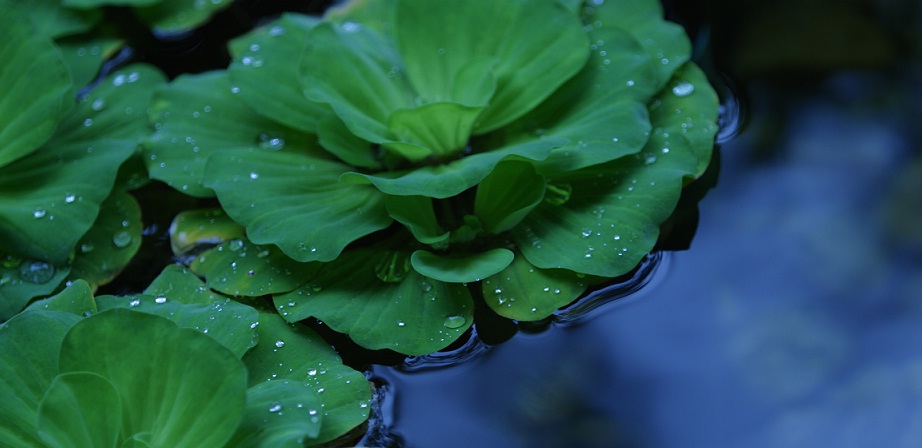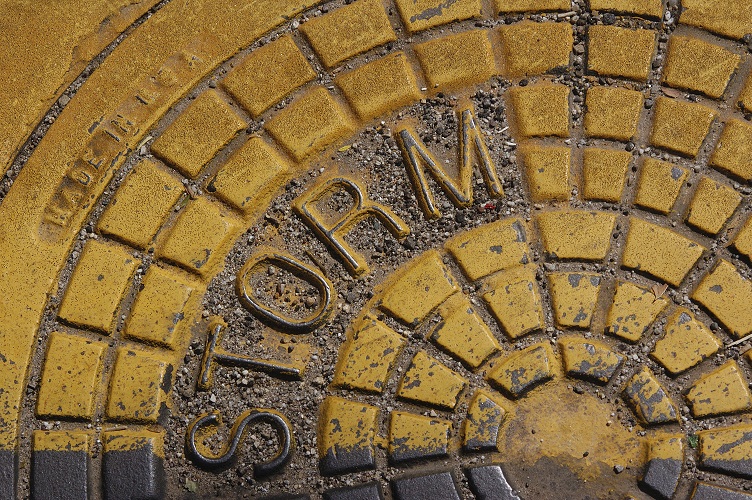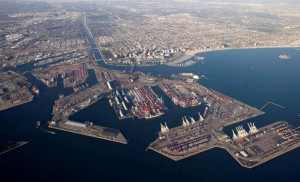
An aerial view of the Port and City of Long Beach. Image by Port of Long Beach
Located in a highly industrial, urban watershed just south of Los Angeles, the Port of Long Beach is 1300 ha (3200 ac) of mostly paved surfaces constructed on top of fill material, where the ocean has been converted to land. Sitting nearly at sea level, the site is ideal for unloading and stacking cargo from ships, and most of the site is devoted to container terminals.
The Port of Long Beach also has shallow, saline groundwater that is tidally influenced, so the water depth changes throughout the day. This shallow groundwater and the man-made land mean that infiltrating stormwater into the soil is not an option across much of the port. Not only would that water have nowhere to go, infiltration could undermine the structural integrity of the port’s fill-material foundation.
Despite significant challenges to managing stormwater using low impact development (LID), the Port of Long Beach is committed to using LID where possible and has developed a port-specific LID manual.
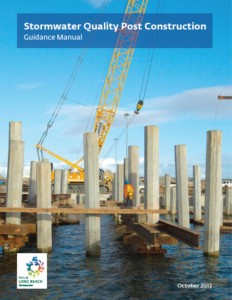
The Port of Long Beach LID manual
Port-Specific LID Manual
In 2010, the City of Long Beach adopted an ordinance requiring most new and redevelopment projects in the city to incorporate LID as specified in its LID best management practice manual.
The Port of Long Beach, however, needed a manual that was more specific to its unique environment. For 80 years, large parts of the port were used for oil production, leaving legacy soil- and groundwater-contamination in some areas. Among its challenges, the port has to take care not to mobilize this contamination.
Additionally, groundwater in some areas of the port is only 2 m (6 ft) below the ground surface, making infiltration infeasible.
In the past, ships were smaller and took longer to unload, so ports needed more slips where ships could dock. With increasingly larger ships and containerized cargo, ports now need fewer slips and more backland area to stack the containers. The Port of Long Beach is in the process of creating nearly 50 ha (120 ac) of new land by filling in slips. Because most of the port is built on fill material, liquefaction — where the soil’s strength and stiffness is reduced — is a key geotechnical concern when considering stormwater infiltration.
Because of these challenges, finding sites that are appropriate for LID can be difficult. “Many times we are precluded from using LID for certain reasons, but we want to incorporate LID as much as possible,” said James Vernon, manager of water quality practices at the Port of Long Beach.
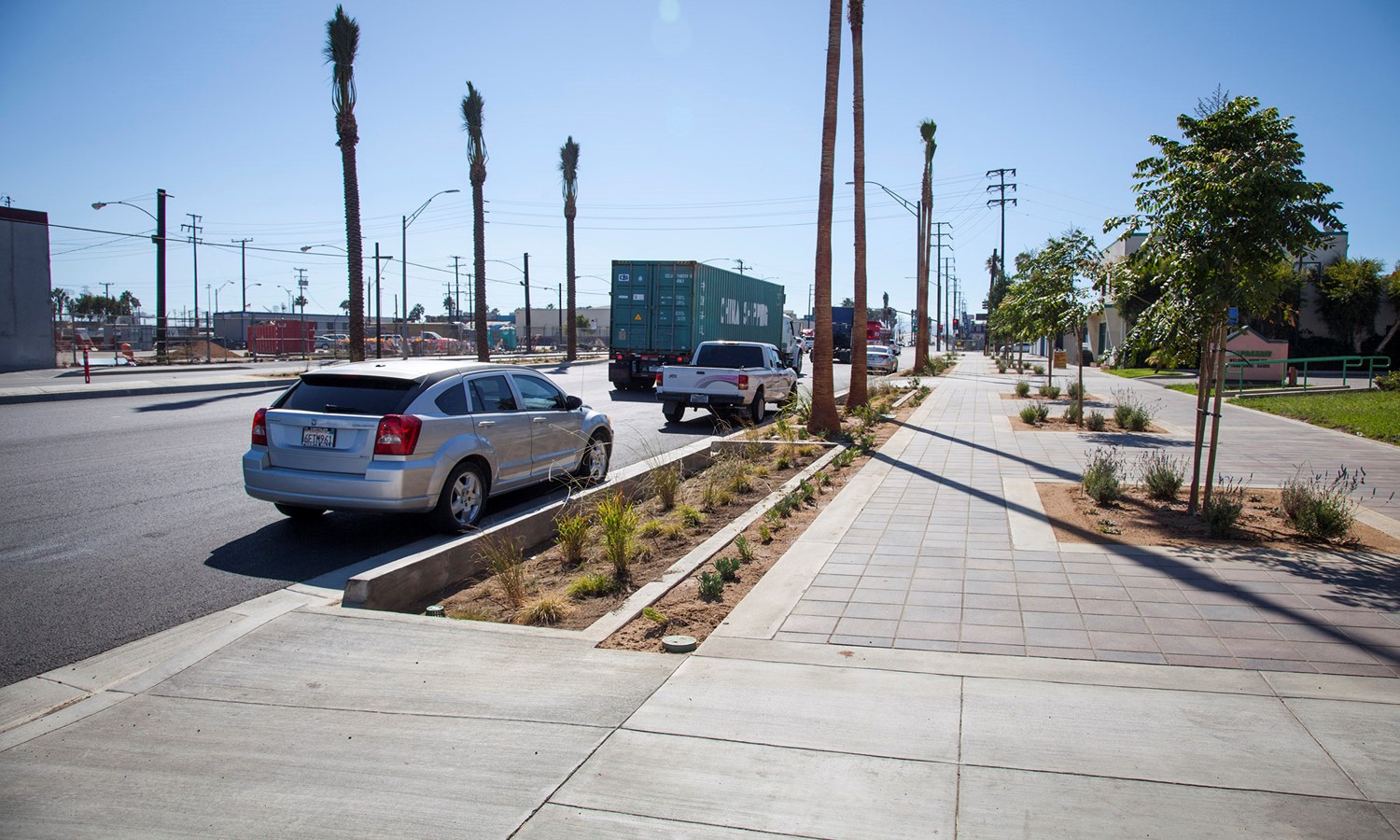
The Port of Long Beach’s award-winning Anaheim Green Street project with bioswales, permeable pavers, and drought-tolerant landscaping. Image by Port of Long Beach
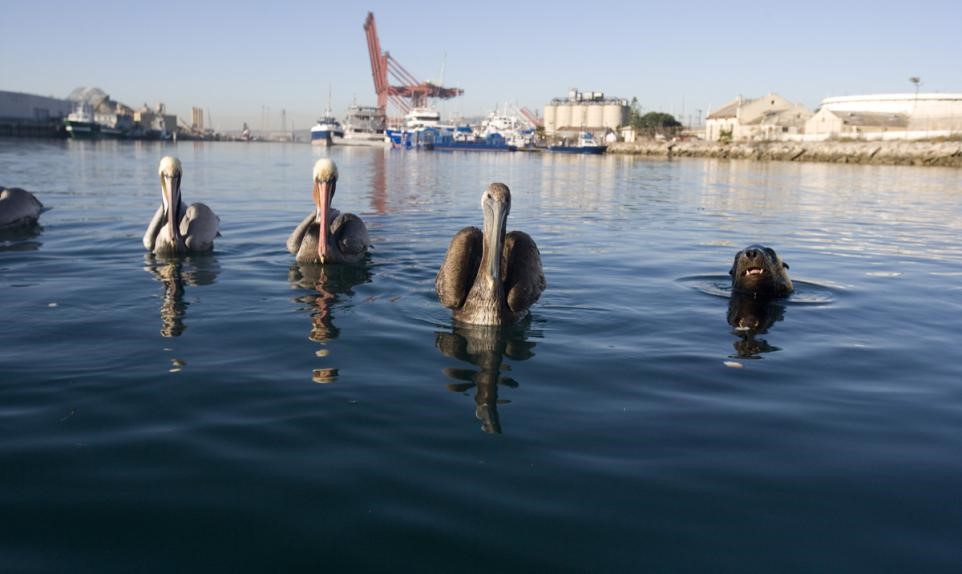
Port of Long Beach locals. Image by Port of Long Beach
For 10 years, the Port of Long Beach has employed a Green Port Policy that covers such resource areas as soil, water, air, and wildlife. Developing a port-specific LID manual was a control measure included within the port’s Water Resources Action Plan. The policy also supports efforts to make each building constructed within the port meet the U.S. Green Building Council’s standards of at least Leadership in Energy & Environmental Design (LEED) silver.
Vetted by the City of Long Beach, the port’s manual describes how LID projects should be implemented at the Port of Long Beach and within the city’s Harbor District. The port’s Environmental Planning Division issues permits for all port and harbor development projects, enabling the port to ensure that LID is applied when appropriate.
Vernon also keyed in on the challenge and importance of maintenance. “You have to make sure responsible entities are maintaining best management practices as required,” he said. “We check maintenance records and do inspections.”
Stormwater as a Resource
Across the U.S., there is an Increasing focus on infiltration-based stormwater controls. Especially in California, which declared a drought state of emergency at the start of 2014, stormwater is increasingly seen as a resource. In June, the California State Water Resources Control Board announced a new permit for Los Angeles County and more than 80 municipal permittees that encourages LID and groundwater recharge. Then, in July, Los Angeles County released proposed plans to develop a countywide network of stormwater capture and improvement projects.
The Los Angeles Basin Water Augmentation Study, completed in 2010 and led by the Los Angeles-based nonprofit Council for Watershed Health (CWH), examined how infiltrating stormwater affects groundwater quality. Over the long term, groundwater quality was stable or improved for most constituents at monitored sites with shallow groundwater. Soils removed bacteria from stormwater, and researchers did not detect volatile organic compounds in groundwater. In some cases, concentrations of inorganic constituents even decreased in groundwater when compared to polluted stormwater.
LID for Industrial Facilities
“The study demonstrated that infiltration is feasible for augmenting groundwater supplies,” said Christopher Solek, CWH senior scientist. Yet, it is important to consider site constraints, such as groundwater levels, soils, and pollutant constituents. Some industrial sites may have greater potential to contaminate groundwater.
“There is a large gamut of industrial facilities,” Solek said. Each will have unique considerations and constituents of concern that determine the appropriateness of LID. For instance, the California Industrial General Permit, which took effect in July, regulates discharges associated with 10 broad categories of industrial activities, from landfills and recycling operations, to transportation facilities, to manufacturing sites.
Compliance with these new permit requirements will be a challenge for many facilities across the state. However, LID presents one set of compliance options.
“For industrial facilities, LID is a good way to reduce the volume of stormwater running off of a site,” Vernon said. If infiltrating stormwater, however, “you have to ensure that you are not putting contaminants into the ground.” For instance, an industrial site with very water-soluble contaminants may not be a good match for infiltration-based practices.
LID at the Port
In 2014, CWH hosted “Transportation and Heavy Industry in an Era of Low Impact Development,” an event where leading players in transportation and other industries discussed environmental challenges, successes, and how to drive regional sustainability. Vernon shared the Port of Long Beach’s experience implementing LID. According to Vernon, LID works best upstream of the port facilities, where it reduces the volume of runoff entering the port complex. There also are more natural areas of the port not built on fill material that can accommodate LID approaches.
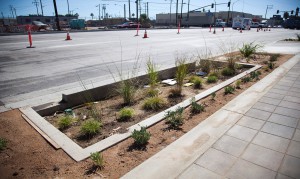
Anaheim Green Street Project bioswales with drought-tolerant landscaping. Image by Port of Long Beach
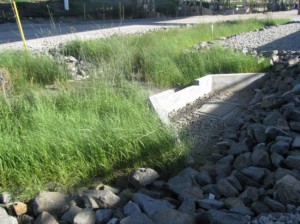
A bioswale with erosion- and trash-control best management practices at an orphan site. Image by Port of Long Beach
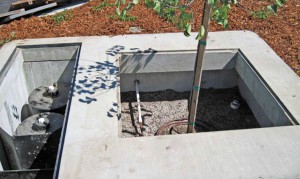
A tree-box filter with filter canisters. Image by Port of Long Beach
The nearly mile-long, award-winning Anaheim Street project is the port’s most visible LID installation. The road is a major truck arterial at the north end of the harbor district that handles about 30,000 vehicle trips daily, including 5000 heavy-duty trucks servicing the port. The $8-million, green street project includes seven bioswales, permeable pavers, and three tree-box filters along with other sustainable improvements, such as drought-tolerant landscaping and drip irrigation.
In an approximately $7-million project, the port also is using LID to manage stormwater on so-called orphan sites — oddly shaped parcels that the port cannot rent to its tenants. The port installed bioswales, erosion and trash-capture controls, and drought tolerant landscaping at the orphan sites to improve stormwater quality and reduce the effects of airborne dust.
Where infiltration does not make sense, the port is testing flow-through planters. These systems use landscaping and media to filter stormwater but have an impermeable bottom with an under drain. Another option is capturing and using rainwater in the port’s operations. Yet, with 80% of its land comprised of container terminals, the port has little need for the water at most of its tenant facilities.
However, two port facilities, a metal recycler and petroleum coke exporter, are taking advantage of rainwater harvesting for dust control. Both are zero-discharge facilities with 3785-m3 (1 million gal) tanks for collecting rainwater. Harvesting helps to alleviate drought conditions by reducing these facilities’ demand for potable water, and it improves stormwater quality by eliminating discharges and associated pollutant loads.
Additionally, all harbor oil production facilities capture rainwater. For every barrel of oil harvested, these facilities must inject 1.1 barrels of water into the geologic formation to prevent land subsidence or sinking. Considered zero-discharge facilities as well, these bowl-shaped sites capture stormwater and inject it into the ground rather than using potable water.
Where the port cannot use LID, it relies on traditional stormwater controls, such as vortex separator treatment systems. These separators can remove sediment, trash, and oil from stormwater and are helping the port comply with the Harbor Toxics Total Maximum Daily Load. With heavy traffic common in the port environment, below-ground systems can be a good fit.
“LID techniques are very powerful tools for improving stormwater quality and recharging our groundwater resources,” Vernon said. However, stormwater management in the port environment is about using the right tool in the right place. “Accordingly, we implement more traditional stormwater treatment technologies in those situations where LID cannot be applied. Both types of systems are integral to helping the port achieve its water resources objectives and making the Port of Long Beach The Green Port.”

